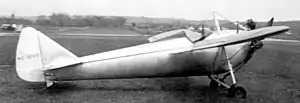| Bull Pup | |
|---|---|
 | |
| Role | Sportsplane |
| Manufacturer | Buhl |
| Designer | Etienne Dormoy[1] |
| First flight | 1930 |
| Number built | ca. 100 |
The Buhl LA-1 Bull Pup was a light sports airplane developed in the United States in 1930. It was a mid-wing wire-braced monoplane with fixed tailskid undercarriage and an open cockpit for the pilot. Buhl developed the Bull Pup as a cheap aircraft through which the company hoped to remain in business as the onset of the Great Depression was felt. However, as the economic situation worsened, it became evident that there was no demand for even such a basic aircraft; when production ceased in 1932, all aircraft still in stock were sold off at half price as the company folded.
Variants

Bull Pup c.1936

Ted Lowe and Joe Palwicki with a Bull Pup, May 1936
- LA-1 Bull Pup
- LA-1A Bull Pup – version for competition flying with 28 ft wingspan
- LA-1B Bull Pup – version for high-altitude flying with 32 ft wingspan
- LA-1S Bull Pup – floatplane version
Specifications (L-1)
Data from Aviation[2]
General characteristics
- Crew: 1
- Length: 19 ft 0 in (5.79 m)
- Wingspan: 30 ft 0 in (9.14 m)
- Height: 6 ft 6 in (1.98 m)
- Wing area: 109.4 sq ft (10.16 m2)
- Empty weight: 550 lb (249 kg)
- Gross weight: 850 lb (386 kg)
- Fuel capacity: 10 US gal (8.3 imp gal; 38 L)
- Powerplant: 1 × Szekely SR-3 three-cylinder radial engine, 45 hp (34 kW)
Performance
- Maximum speed: 98 mph (158 km/h, 85 kn)
- Cruise speed: 78 mph (126 km/h, 68 kn)
- Range: 260 mi (420 km, 230 nmi)
- Service ceiling: 14,000 ft (4,300 m)
- Rate of climb: 780 ft/min (4.0 m/s)
See also
References
- "Flying Equipment: Approved Type Certificates". Aviation. Vol. 30, no. 5. May 1931. p. 311.
- "Flying Equipment: The Buhl "Bull Pup"". Aviation. Vol. 30, no. 4. April 1931. pp. 249–250.1
- Gunston, Bill (1993). World Encyclopedia of Aircraft Manufacturers. Annapolis: Naval Institute Press. p. 61.
- Taylor, Michael J. H. (1989). Jane's Encyclopedia of Aviation. London: Studio Editions. p. 216.
- "Table 1: American Airplane Specifications: Passenger Planes With Seats For Fewer Than Four Persons". Aviation. Vol. 30, no. 7. July 1931. pp. 426–427, 430.
- aerofiles.com
External links
Wikimedia Commons has media related to Buhl LA-1 Bull Pup.
This article is issued from Wikipedia. The text is licensed under Creative Commons - Attribution - Sharealike. Additional terms may apply for the media files.